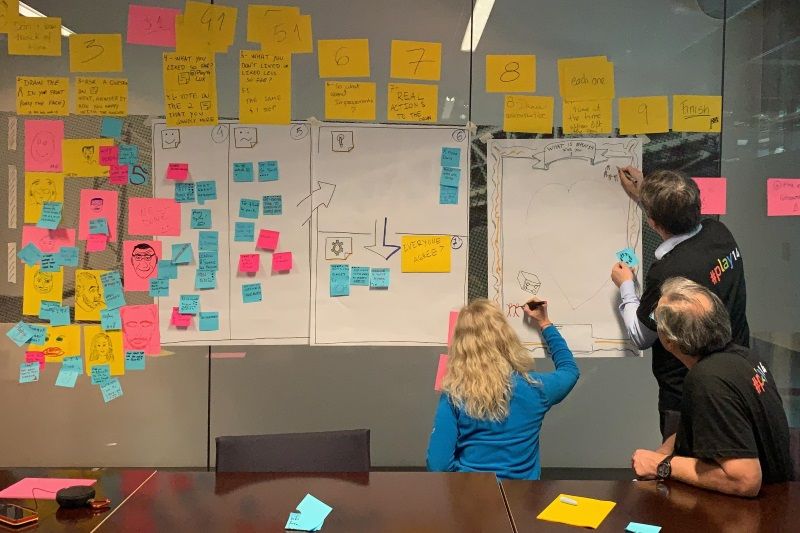Before you start
Write down the rules and agenda
Rules
- 50 minutes of retrospective
- No speaking
- You can add a post-it on the parking lot any time
Agenda
- Check-in
- Icebreaker
- What went well, not so well and improvements
- Collaborative Drawing
Start the retrospective
First, you need to prepare the room and put some music (10 minutes before start the meeting). The music is very important to the process, because you will capture the attention of the team. So you need to know a little about them to choose it wisely! Avoid to use music with lyrics.
When the team arrives, you show the rules and the agenda. Write on the post-it "Welcome". Use the big post-its to communicate.
Check in
Write down on the post-it "Write on a post-it what you are feeling right know" and show to them. Be sure that everyone understand and see the post-it. Show with movements where to put the post-its on the wall and write "Before you put on the wall, show to your colleges". Now everyone knows what they are feeling and as a team they will support each other.
Each time you finish a part on the agenda, go to the agenda paper and put a tick next to the topic that you just finished. For example, in this case tick "check in". It will help the team to understand the flow better.
Strength
This part is very important for the meeting, because it will show them how they will work on the rest of the meeting.
Write down on the post-it "Draw the person on your right. Only the head." Show them to put the post-its on the wall. Now, write on the post-it: "Write down a strength of that person". When everyone has written and put on the wall, show another post-it "Now, only draw a strength for the person on your left". Everyone will put the post-it over the big post-it with the faces. Next, write down "Try to guess what strength it is". They will write on the post-it or on another post-it, do not worry, they are on the game… Finally write "Write on the post-it that you draw, what strength it was". You start to feel good energy on the room, they are know ready for the next step. Do not forget to go to the agenda and update the progress.
What went well, not so well and improvements
This part will be the main goal of this meeting.
- Write on a post-it:
- "Write on post-its what things went well during the sprint"* and show them the flip-chart to put them on.
- Tip: You can draw a smiley face on the paper.
- After they put all post-its, "ask" them if it is ok. You can use a gesture as well. Be sure that you show it to everyone.
- Write on a post-it "Vote for the top 2 post-its that you find most important. Use 2 dot votes". You can choose more or less dots for the vote. It depends on how many post-its you have on the flip-chart.
- Now repeat the process (3.1) but for the "Not so well" flip-chart.
- Now repeat the process (3.1) for the improvement.
- After you have the top 3 improvements, you will need some actions.
- So write on a post-it "For this 3 improvements, lets create real actions". Show them to put the actions near on the post-its of the improvements.
- After, you must confirm that everyone accepts the actions, by writing down "See what actions you as a team accept to do on the next sprint".
- They will work as a self-organized team and they will find a way to communicate…
- Be alert on this part, sometimes they need some guidance, like how to create a great actions (driver, time to review it, what value, …). Ask the some powerful questions to thing about it.
Collaborative Drawing
Finally this part will work like a check-out.
On the white flip-chart, you will put a post-it with the next challenge : "Write a free line that represent the sprint", next show the next post-it "The rule is simple, you are only allow to draw if your pen continuously touches the paper." Show them what they can do and what they can't do on a post-it.
Let the magic begins…
Now show them a post-it "Now you can speak". Be prepare to the their reaction…
Facilitation
Give the team some feedback during the meeting. For example, at the end of each big step.
Main take-aways
Silence is powerful. We can do so more with less.
More
Here a re some interesting links
Silent retrospective feedback
